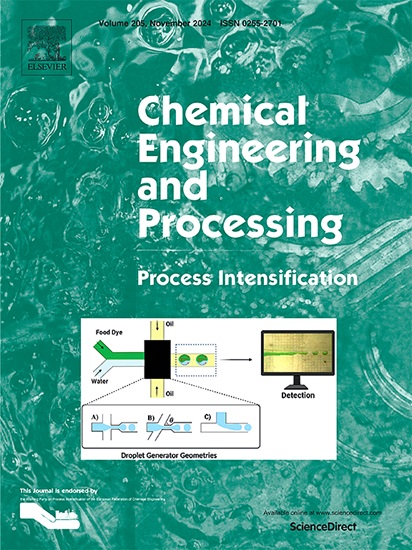Ultrasonic-assisted alkali leaching coupled gas sorting process to separate cathode and anode materials from spent LiFePO4 batteries
IF 3.8
3区 工程技术
Q3 ENERGY & FUELS
Chemical Engineering and Processing - Process Intensification
Pub Date : 2025-02-06
DOI:10.1016/j.cep.2025.110207
引用次数: 0
Abstract
With the rapid development of lithium-ion batteries, the recycling of spent batteries represents a major future challenge, particularly LiFePO4 batteries (LFP) due to their structural stability and high safety. This study proposes a simple and efficient pretreatment process, employing a combination of ultrasonic-assisted dilute alkali leaching and crushing-gas sorting to separate the cathode and anode material from spent LFP, respectively. The key parameters that affect the recovery efficiency of cathode materials from Al foil have been determined, including alkali concentration, liquid-solid ratio, ultrasonic frequency, and ultrasonic time. The separation efficiency between Al foil and cathode material can achieved 99.85 %. The interface effect generated by the ultrasound cavitation promotes the separations of Al foil and cathode active materials. Meanwhile, the optimal crushing-gas sorting process parameters including particle size and gas flow rate was determined to recover Cu foil and graphite from the anode active material. A Cu recovery efficiency of 87.2 % with a Cu grade of 84.6 % was reached. Additionally, treatment with 3 % HCl for 90 min was introduced to remove the residual Li in the recovered graphite. This method can provide a more efficient and sustainable way for the comprehensive separation and recovery of active materials from spent lithium-ion batteries.

超声辅助碱浸耦合气体分选法分离废旧LiFePO4电池正极材料
随着锂离子电池的快速发展,废旧电池的回收是未来的主要挑战,特别是LiFePO4电池(LFP)由于其结构稳定性和高安全性。本研究提出了一种简单高效的预处理工艺,采用超声辅助稀碱浸出和破碎气分选相结合的方法,分别从废LFP中分离正极材料和负极材料。确定了碱浓度、液固比、超声频率和超声时间等影响铝箔正极材料回收率的关键参数。铝箔与正极材料的分离效率可达99.85%。超声空化产生的界面效应促进了铝箔与正极活性材料的分离。同时,确定了从阳极活性材料中回收铜箔和石墨的最佳破碎-气体分选工艺参数,包括粒度和气体流量。铜回收率为87.2%,铜品位为84.6%。此外,采用3%盐酸处理90分钟,以去除回收石墨中的残余锂。该方法可为废旧锂离子电池中活性物质的综合分离与回收提供一种更高效、可持续的途径。
本文章由计算机程序翻译,如有差异,请以英文原文为准。
求助全文
约1分钟内获得全文
求助全文
来源期刊
CiteScore
7.80
自引率
9.30%
发文量
408
审稿时长
49 days
期刊介绍:
Chemical Engineering and Processing: Process Intensification is intended for practicing researchers in industry and academia, working in the field of Process Engineering and related to the subject of Process Intensification.Articles published in the Journal demonstrate how novel discoveries, developments and theories in the field of Process Engineering and in particular Process Intensification may be used for analysis and design of innovative equipment and processing methods with substantially improved sustainability, efficiency and environmental performance.

 求助内容:
求助内容: 应助结果提醒方式:
应助结果提醒方式:


